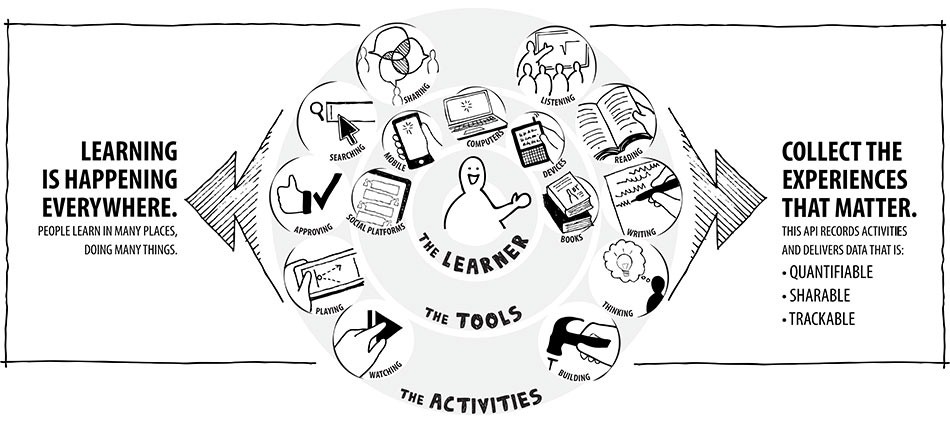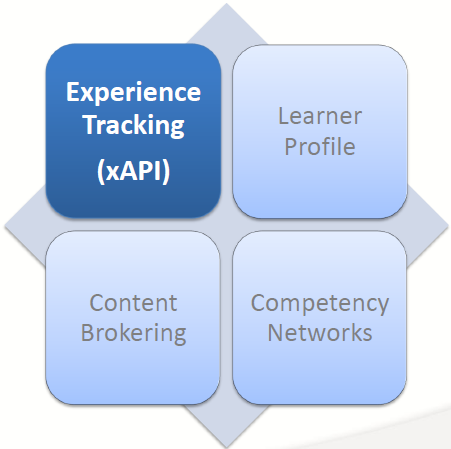Introduction to xAPI
The Experience API (xAPI), initially called “Tin Can,” was released on April 26th, 2013. There are already over 90 adopters of xAPI and the level of industry “buzz” has been unprecedented. So what is it? Is it something you should know about? In this article we’ll give you an introduction to xAPI and show how it’s impacting the learning industry. We’ll also show you the benefits of xAPI and how it can help record a wide range of learning experiences for your students. This is part 1 of a two part article.
| Note: “Tin Can” and xAPI are the same thing. The “official” name for the standard is the Experience API, or xAPI. Technically, Tin Can was the name of the project that collected information on developing the standard, and xAPI is the result of that project. But the Tin Can name has stuck, and you are just as likely to hear adopters talk about Tin Can as you are xAPI. |
What is xAPI?
The Experience API is a learning technology specification that makes it possible to collect data about your student’s learning experiences. You might say “But that’s what my LMS does. Why do I need something else?” While it is true that the LMS captures your instructor-led learning and your eLearning, much informal learning occurs outside the system. Consider experiential learning, learning games, virtual worlds, social learning, simulations…are you capturing those learning experiences?

xAPI makes it possible to capture learning that occurs outside your learning management system. RISC was an early adopter of xAPI and VTA was the first LMS to be compliant with version 1.0 of the specification.
History
AICC
The Aviation Industry CBT Comittee (AICC) standard for LMS to training content communication was developed in the early 1990’s. It defined how an LMS would launch an “assignable unit” (e-learning) and receive results. AICC is a relatively simple standard to implement and is still widely used today.
SCORM
SCORM, which stands for Shareable Content Object Reference Model, is the most well-known and popular of the LMS to content specifications. Like the AICC standard, SCORM defines LMS to training content communication. Designed for the desktop, SCORM also defines common packaging, communication and launching mechanisms.
Most people don’t know it, but SCORM was originally based on the AICC model. There are currently two versions:
- SCORM 1.2
This version was released in 2001. - SCORM 2004
Released in 2004, this version has been updated several times.
Why do we need something new?
Problems with SCORM
There are many problems with SCORM…so many problems that ADL commissioned a study, “Project Tin Can”, to define the problems and come up with a solution. Here are a few problems with SCORM:
- All learning MUST be launched from an LMS
As we discussed earlier in this article, much learning occurs outside the LMS. SCORM cannot capture it. - Content must reside in the same domain as the LMS
According to the SCORM specification, the training content and the LMS must reside in the same “domain”, which basically means they must be on the same web server(s). Since content is often the biggest bandwidth user in a learning environment (videos, images, voice-over, etc), it would be desirable to have the LMS and the content in separate domains. In addition, content distribution networks (CDN) could be used to put content closer to students. - SCORM is complicated
The SCORM 2004 specification is literally over 600 pages long, and that is just the
specification document itself. The total size of all SCORM documents is over 4,000 pages! - SCORM content MUST run in a browser
So, no mobile apps, no “off line” content, no simulators… - SCORM is easily hacked
No, I won’t tell you how, but it is actually farily easy to falsify SCORM results due to the old technology used by SCORM.
The list of problems in SCORM goes on and on…you can find out more on the ADL website if you are interested.
The Changing Landscape
There are many environmental factors to learning that also aren’t considered by SCORM.
- Proliferation of mobile devices
The number of mobile devices exceeds the world’s population. SCORM is not designed to handle mobile learning. - Social Learning
It is estimated that 70-80% of learning is informal, social learning, vs. 20-30% formal learning. Assuming this number is even remotely accurate, that’s a lot of learning that we are not capturing. Your students are learning from Yammer, Blogs, Wikis, Twitter, Facebook and YouTube…what are they learning? - Gamification and Simulations
Gaming is becoming a widely used learning tool. For example, some companies are using Second Life to teach customer service skills. The U.S. Army uses gaming and simulations to teach critical skills required to store ammunition safely. Since SCORM doesn’t work outside the browser, these learning experiences cannot be tracked.
The Training & Learning Architecture (TLA)
Developed by ADL, the TLA is the next generation of SCORM. It does not replace SCORM — the vision is that the next generation of SCORM will live inside the TLA. xAPI is the first component of the TLA to be released.

The TLA includes:
- xAPI
The new API, data structure and storage mechanism. - Content Brokering
The purpose of Content Brokering is to support just-in-time learning by enabling logical selection of the “next” learning activity. - Learner Profile
This specification will compile data about a learner to include previous completions, competencies, preferences, learning style and portfolios. - Competency Networks
This specification will establish a common way for content and systems to reference learning objectives and competencies.
xAPI Benefits
The new xAPI specification has many benefits and overcomes long-standing problems with SCORM.
- Learning experiences outside of the LMS can be recorded.
- Learning content does not have to reside in a browser (iPad or tablet anyone?).
- Learning does not need to be “launched” from an LMS, enabling:
a. Mobile Apps
b. Social Learning
c. Gaming & Simulations - Learning content can be distributed.
This is becoming more important as content modules get larger and larger. If you can use a CDN to get content closer to your students, no matter where they reside in the world, you can improve their learning experience. - xAPI uses modern, common technology (REST and JSON).
Many types of applications – not just browsers – can use these technologies. - Simplicity!
The xAPI specification is roughly 70 pages.
Summary
So now we know some of the history behind xAPI, why xAPI was developed, and some of the benefits associated with xAPI. In part 2 of this article we’ll learn how xAPI works, define the Learning Record Store (LRS), and dispel some of the myths about xAPI.
